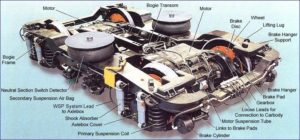 A mechanical transmission couldn’t be made big enough. So, instead, the diesel is used to generate electricity for motors that pull the train. These traction motors develop tremendous torque. That’s how you get all that weight rolling! Trains are pulled by electric motors! Needless to say, a locomotive’s diesel engine, alternator or generator, and traction motors are BIG. For a detailed article about how modern railroad locomotives work, click here. Click on images to enlarge.
A mechanical transmission couldn’t be made big enough. So, instead, the diesel is used to generate electricity for motors that pull the train. These traction motors develop tremendous torque. That’s how you get all that weight rolling! Trains are pulled by electric motors! Needless to say, a locomotive’s diesel engine, alternator or generator, and traction motors are BIG. For a detailed article about how modern railroad locomotives work, click here. Click on images to enlarge.


So unless you electrify the track as is done in many subways or you hand the power line over the rail you need the diesel engine to provide the power to the electric motor.
The first electrified subway opened in London in 1890 so electric rail systems have been around for a long time.
The point of this article is that many people assume the big, noisy diesel turns the wheels, but it doesn’t. That would be like trying to start an F-350 towing a heavy boat trailer in 4th gear, only magnified 10,000x. Thump. Engine stops. Unlike an ICE engine, an electric motor puts out full torque at 0 rpm. Enough to get a train moving from a dead stop. That’s why you convert the diesel’s power output to electricity, and use electric motors to drive the wheels. Diesel locomotives became viable and replaced steamers when engineers figured this out.